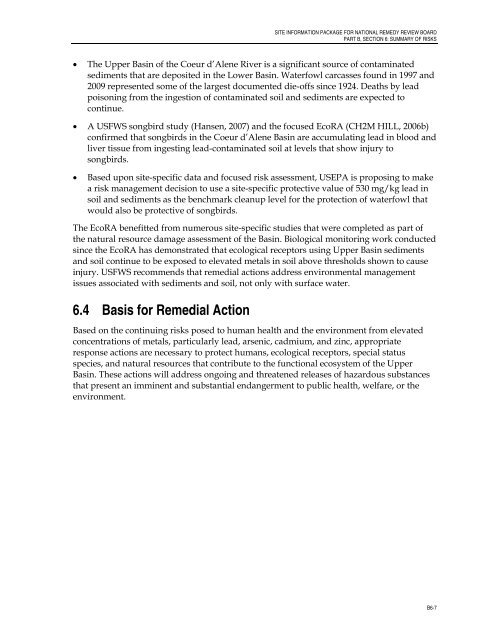Final Site Information Package for National Remedy Review Board ...
Final Site Information Package for National Remedy Review Board ...
Final Site Information Package for National Remedy Review Board ...
You also want an ePaper? Increase the reach of your titles
YUMPU automatically turns print PDFs into web optimized ePapers that Google loves.
SITE INFORMATION PACKAGE FOR NATIONAL REMEDY REVIEW BOARD<br />
PART B, SECTION 6: SUMMARY OF RISKS<br />
• The Upper Basin of the Coeur d’Alene River is a significant source of contaminated<br />
sediments that are deposited in the Lower Basin. Waterfowl carcasses found in 1997 and<br />
2009 represented some of the largest documented die-offs since 1924. Deaths by lead<br />
poisoning from the ingestion of contaminated soil and sediments are expected to<br />
continue.<br />
• A USFWS songbird study (Hansen, 2007) and the focused EcoRA (CH2M HILL, 2006b)<br />
confirmed that songbirds in the Coeur d’Alene Basin are accumulating lead in blood and<br />
liver tissue from ingesting lead-contaminated soil at levels that show injury to<br />
songbirds.<br />
• Based upon site-specific data and focused risk assessment, USEPA is proposing to make<br />
a risk management decision to use a site-specific protective value of 530 mg/kg lead in<br />
soil and sediments as the benchmark cleanup level <strong>for</strong> the protection of waterfowl that<br />
would also be protective of songbirds.<br />
The EcoRA benefitted from numerous site-specific studies that were completed as part of<br />
the natural resource damage assessment of the Basin. Biological monitoring work conducted<br />
since the EcoRA has demonstrated that ecological receptors using Upper Basin sediments<br />
and soil continue to be exposed to elevated metals in soil above thresholds shown to cause<br />
injury. USFWS recommends that remedial actions address environmental management<br />
issues associated with sediments and soil, not only with surface water.<br />
6.4 Basis <strong>for</strong> Remedial Action<br />
Based on the continuing risks posed to human health and the environment from elevated<br />
concentrations of metals, particularly lead, arsenic, cadmium, and zinc, appropriate<br />
response actions are necessary to protect humans, ecological receptors, special status<br />
species, and natural resources that contribute to the functional ecosystem of the Upper<br />
Basin. These actions will address ongoing and threatened releases of hazardous substances<br />
that present an imminent and substantial endangerment to public health, welfare, or the<br />
environment.<br />
B6-7

















